The Improved (G’/G)-Expansion Method for the (2+1)-Dimensional Modified Zakharov-Kuznetsov Equation
Abstract
we apply the improved (G′/G)-expansion method for constructing abundant new exact traveling wave solutions of the (2+1)-dimensional Modified Zakharov-Kuznetsov equation. In addition, G″ + λG′ + μG = 0 together with is employed in this method, where pq (q = 0, ±1, ±2, …, ±w), λ and μ are constants. Moreover, the obtained solutions including solitons and periodic solutions are described by three different families. Also, it is noteworthy to mention out that, some of our solutions are coincided with already published results, if parameters taken particular values. Furthermore, the graphical presentations are demonstrated for some of newly obtained solutions.
1. Introduction
The investigations of traveling wave solutions for nonlinear evolution equations (NLEEs) play an outstanding role in analysing nonlinear physical phenomena. In the recent past, a wide range of methods have been presented to establish analytical solutions for nonlinear partial differential equations (PDEs), such as the Backlund transformation method [1], the inverse scattering method [2], the homogeneous balance method [3], the Hirota bilinear transformation method [4], the Jacobi elliptic function expansion method [5–7], the generalized Riccati equation method [8], the tanh-coth method [9–11], the F-expansion method [12, 13], the direct algebraic method [14], the Cole-Hopf transformation method [15], the Exp-function method [16–23], the Adomian decomposition method [24], the homotopy analysis method [25], the bifurcation method [26, 27], and others [28–40].
Wang et al. [42] presented the basic (G′/G)-expansion method, and is implemented as traveling wave solutions, where am ≠ 0. Later on, nonlinear partial differential equations are investigated to construct traveling wave solutions via this method [41, 43–50]. More recently, Zhang et al. [51] extended this method and called it the improved (G′/G)-expansion method. They employed the method as traveling wave solutions, where either p−w or pw may be zero, but both p−w and pw cannot be zero at a time. Afterwards, many researchers studied different nonlinear partial differential equations to construct traveling wave solutions by using this improved (G′/G)-expansion method. For example, Zhao et al. [52] executed the same method to establish exact solutions of the variant Boussinesq equations. Nofel et al. [53] constructed traveling wave solutions for the fifth-order KdV equation by using this method. Hamad et al. [54] studied higher-dimensional potential YTSF equation to obtain analytical solutions via the same method. Naher et al. [55] applied this powerful method to construct traveling wave solutions of the higher-dimensional modified KdV-Zakharov-Kuznetsev equation. In [56], Naher and Abdullah were concerned about the same method to obtain exact solutions for the nonlinear reaction diffusion equation whilst in [57] they investigated the combined KdV-MKdV equation for constructing traveling wave solutions by applying this method and so on.
Many researchers studied the (2+1)-dimensional modified Zakharov-Kuznetsov equation by using different methods. For instance, Khalfallah [58] implemented homogeneous balance method to investigate this equation for obtaining exact solutions. In [41], Bekir employed the basic (G′/G)-expansionmethod to construct traveling wave solutions for the same equation. In this basic (G′/G)-expansion method, they utilized , where am ≠ 0, as traveling wave solutions, instead of , where either p−w or pw may be zero, but both p−w and pw cannot be zero at a time.
The significance of this work is that the (2+1)-dimensional modified Zakharov-Kuznetsov equation is considered to construct many new exact traveling wave solutions including solitons, periodic, and rational solutions by applying the improved (G′/G)-expansion method.
2. Description of the Improved (G′/G)-Expansion Method
The main steps of the improved (G′/G)-expansion method [51] are as follows.
Step 1. Consider the traveling wave variable
Step 2. According to possibility, (2.3) can be integrated term by term one or more times, yielding constant(s) of integration. The integral constant may be zero, for simplicity.
Step 3. Suppose that the traveling wave solution of (2.3) can be expressed in the form [51]
Step 4. To determine the integer w, substitute (2.4) along with (2.5) into (2.3) and then take the homogeneous balance between the highest-order nonlinear terms and the highest-order derivatives appearing in (2.3).
Step 5. Substitute (2.4) and (2.5) into (2.3) with the value of w obtained in Step 4. Equate the coefficients of (G′/G)r, (r = 0, ±1, ±2, …) and then set each coefficient to zero and obtain a set of algebraic equations for pq (q = 0, ±1, ±2, …, ±w), C, λ, and μ.
Step 6. By solving the system of algebraic equations which are obtained in Step 5 with the aid of algebraic software Maple, and we obtain values for pq (q = 0, ±1, ±2, …, ±w), C, λ and μ. Then, substitute the obtained values in (2.4) along with (2.5) with the value of w to obtain the traveling wave solutions of (2.1).
3. Applications of the Method
In this section, we have studied the (2+1)-dimensional modified Zakharov-Kuznetsov equation to construct new exact traveling wave solutions including solitons, periodic solutions, and rational solutions via the improved (G′/G)-expansion method.
3.1. The (2+1)-Dimensional Modified Zakharov-Kuznetsov Equation
Taking the homogeneous balance between b3 and b′′ in (3.3), we obtain w = 1.
Substituting (3.4) together with (2.5) into (3.3), the left-hand side of (3.3) is converted into a polynomial of (G′/G)r, (r = 0, ±1, ±2, …). According to Step 5, collecting all terms with the same power of (G′/G), and then setting each coefficient of the resulted polynomial to zero, yields a set of algebraic equations (for simplicity, which are not presented) for p−1, p0, p1, C, H, λ, and μ.
Solving the system of obtained the algebraic equations with the help of algebraic software Maple, we obtain three different values.
Case 1. We have
Case 2. We have
Case 3. We have
Substituting the general solution equation (2.5) into (3.4), we obtain three different families of traveling wave solutions of(3.3)
Family 1 (hyperbolic function solutions). When λ2 − 4μ > 0, we obtain
For example,
- (i)
if U = 0 but V ≠ 0, we obtain
(3.9) - (ii)
if V = 0 but U ≠ 0, we obtain
(3.10) - (iii)
if U ≠ 0, U > V, we obtain
(3.11)
Family 2 (trigonometric function solutions). When λ2 − 4μ < 0, we obtain
For example,
- (iv)
if U = 0 but V ≠ 0, we obtain
(3.13) - (v)
if V = 0 but U ≠ 0, we obtain
(3.14) - (vi)
if U ≠ 0, U > V, we obtain
(3.15)
Family 3 (rational function solution). When λ2 − 4μ = 0, we obtain
Family 4 (hyperbolic function solutions). Substituting (3.5), (3.6), and (3.7) together with the general solution equation (2.5) into (3.4) yields the hyperbolic function solution equation (3.8), then using (3.9), our traveling wave solutions become, respectively (if U = 0 but V ≠ 0),
Again, substituting (3.5), (3.6), and (3.7) together with the general solution equation (2.5) into (3.4), we obtain the hyperbolic function solution equation (3.8), then using (3.10), we obtain the following exact solutions, respectively (if V = 0 but U ≠ 0),
Family 5 (trigonometric function solutions). Substituting (3.5), (3.6), and (3.7) together with the general solution equation (2.5) into (3.4) yields the trigonometric function solution equation (3.12), and then using (3.13), we obtain the following solutions, respectively (if U = 0 but V ≠ 0),
Family 6 (rational function solutions). Substituting (3.5), (3.6), and (3.7) together with the general solution equation (2.5) into (3.4), we obtain the rational function solution equation (3.16), and our wave solutions become, respectively (if λ2 − 4μ = 0),
4. Results and Discussion
It is worth declaring that some of our obtained solutions are in good agreement with already-published results, which are presented Table 1. Moreover, some of the newly obtained exact traveling wave solutions are described in Figures 1, 2, 3, 4, 5, 6, 7, 8, 9, 10, 11, 12, 13, and 14.
| Bekir [41] solutions | New solutions |
|---|---|
|
|
|
|
| (iii) If C1 = 0, C2 ≠ 0, μ = 2 and λ = 2 solution equation (4.9) from Bekir [41] (from Section 4) becomes: . |
|
|
|
|
|
|
|
|
|
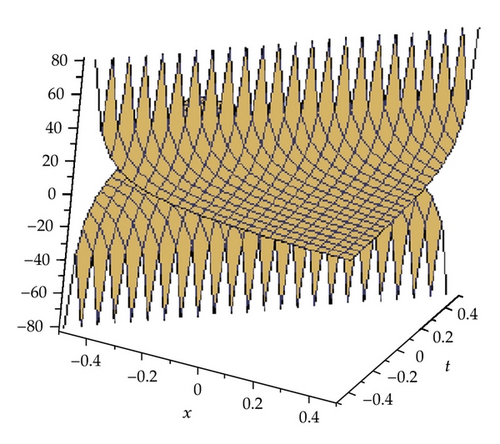
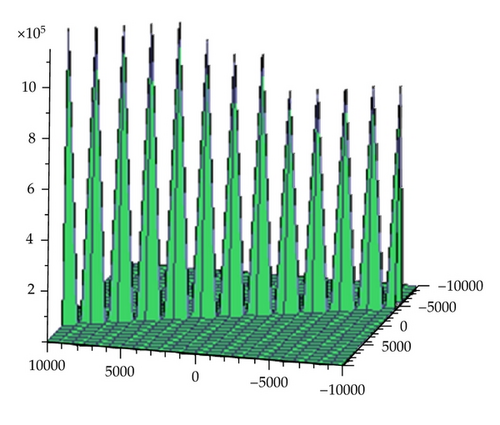
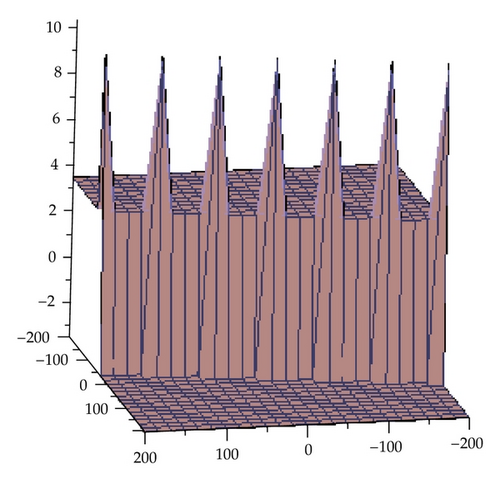
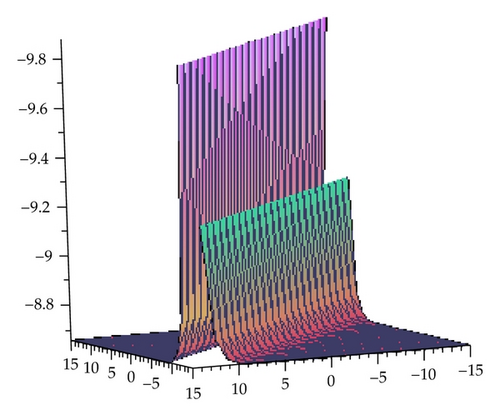
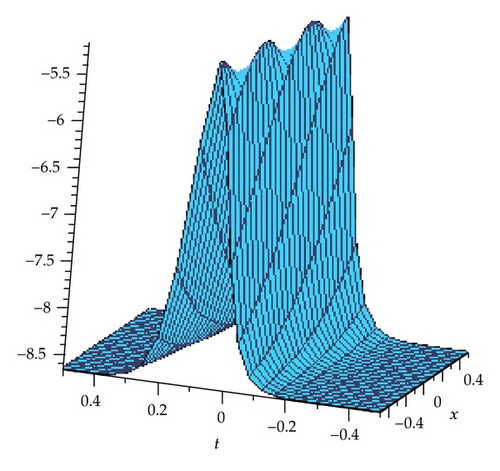
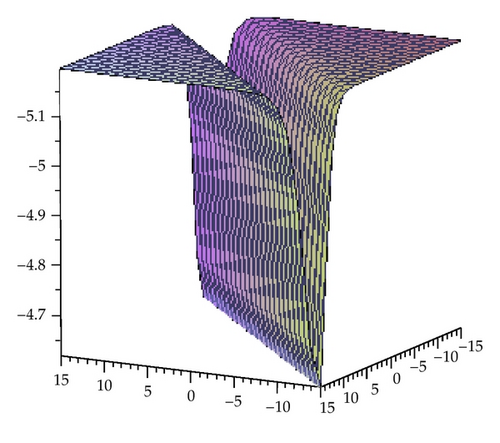
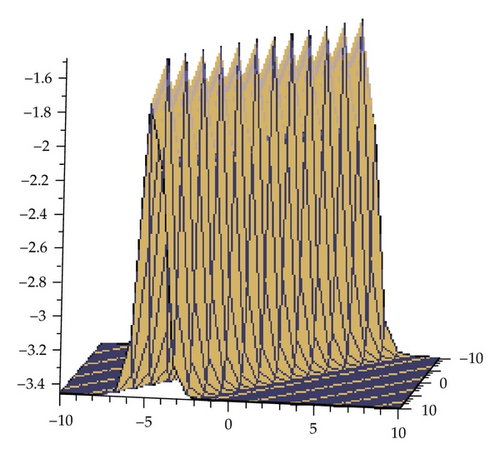
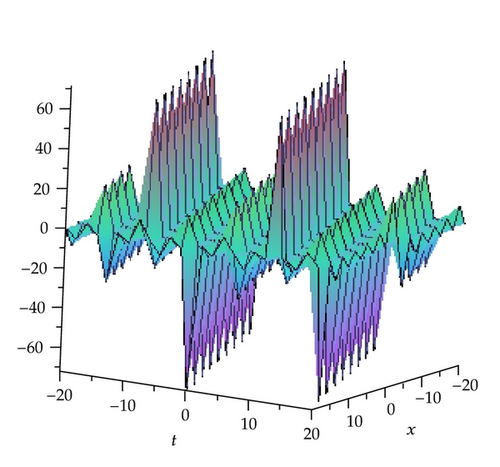
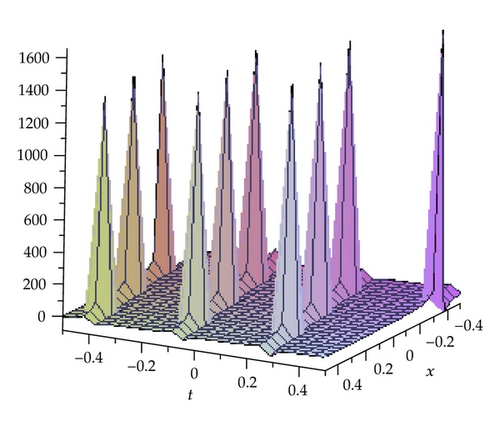
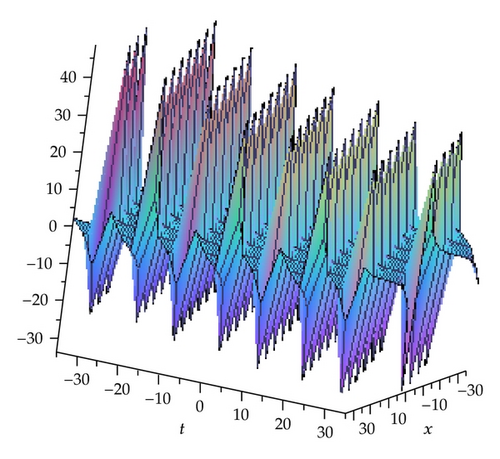
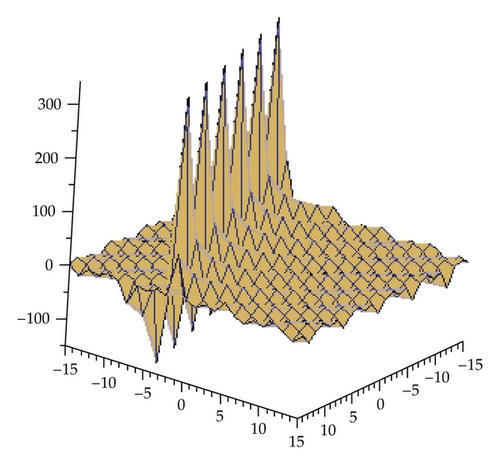


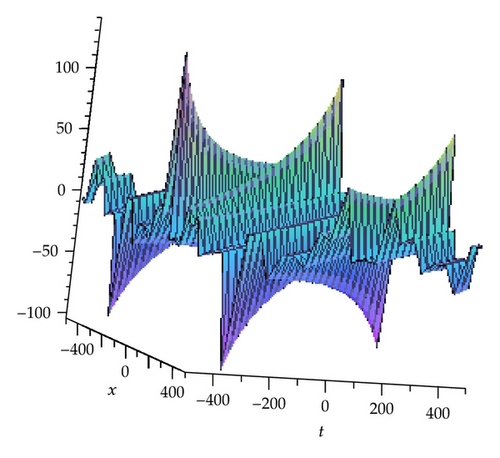
Beyond Table 1, we obtain new exact traveling wave solutions b2, b3, b5, b6, b7, b8, b9, b11, b12, b14, b15, b16, b17, b18, b20, and b21, which are not established in the previous literature.
4.1. Graphical Representations of the Solutions
The graphical presentations of some solutions are depicted in Figures 1–14 with the aid of commercial software Maple.
5. Conclusions
In this paper, the improved (G′/G)-expansion method is implemented to investigate the nonlinear partial differential equation, namely, the (2+1)-dimensional modified Zakharov-Kuznetsov equation. We have constructed abundant exact traveling wave solutions including solitons, periodic, and rational solutions. Moreover, it is worth stating that some of the newly obtained solutions are identical with already-published results, for special case. The obtained solutions show that the improved (G′/G)-expansion method is more effective and more general than the basic (G′/G)-expansion method, because it gives many new solutions. Consequently, this simple and powerful method can be more successfully applied to study nonlinear partial differential equations, which frequently arise in engineering sciences, mathematical physics, and other scientific real-time application fields.
Acknowledgments
This paper is supported by the USM short term Grant (Ref. no. 304/PMATHS/6310072) and the authors would like to express their thanks to the School of Mathematical Sciences, USM for providing related research facilities. The authors are also grateful to the referees for their valuable comments and suggestions.




